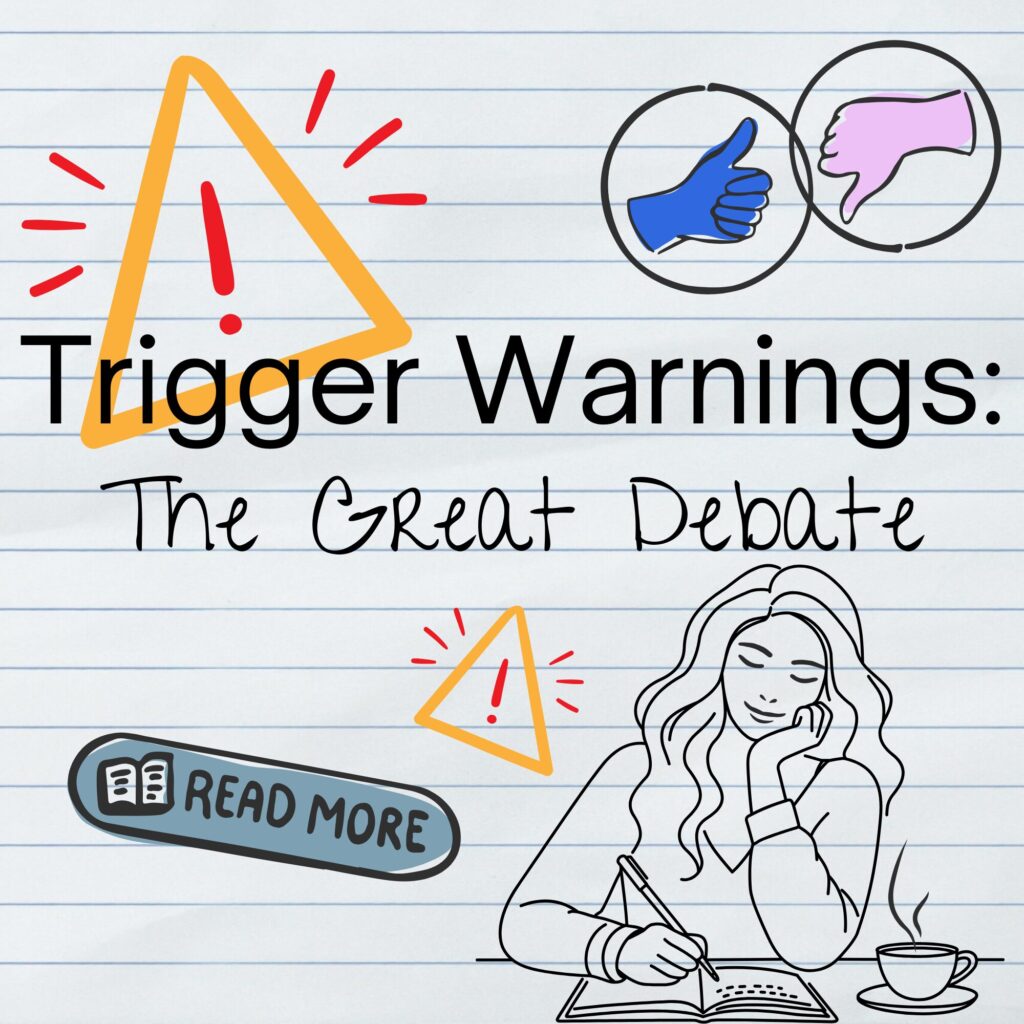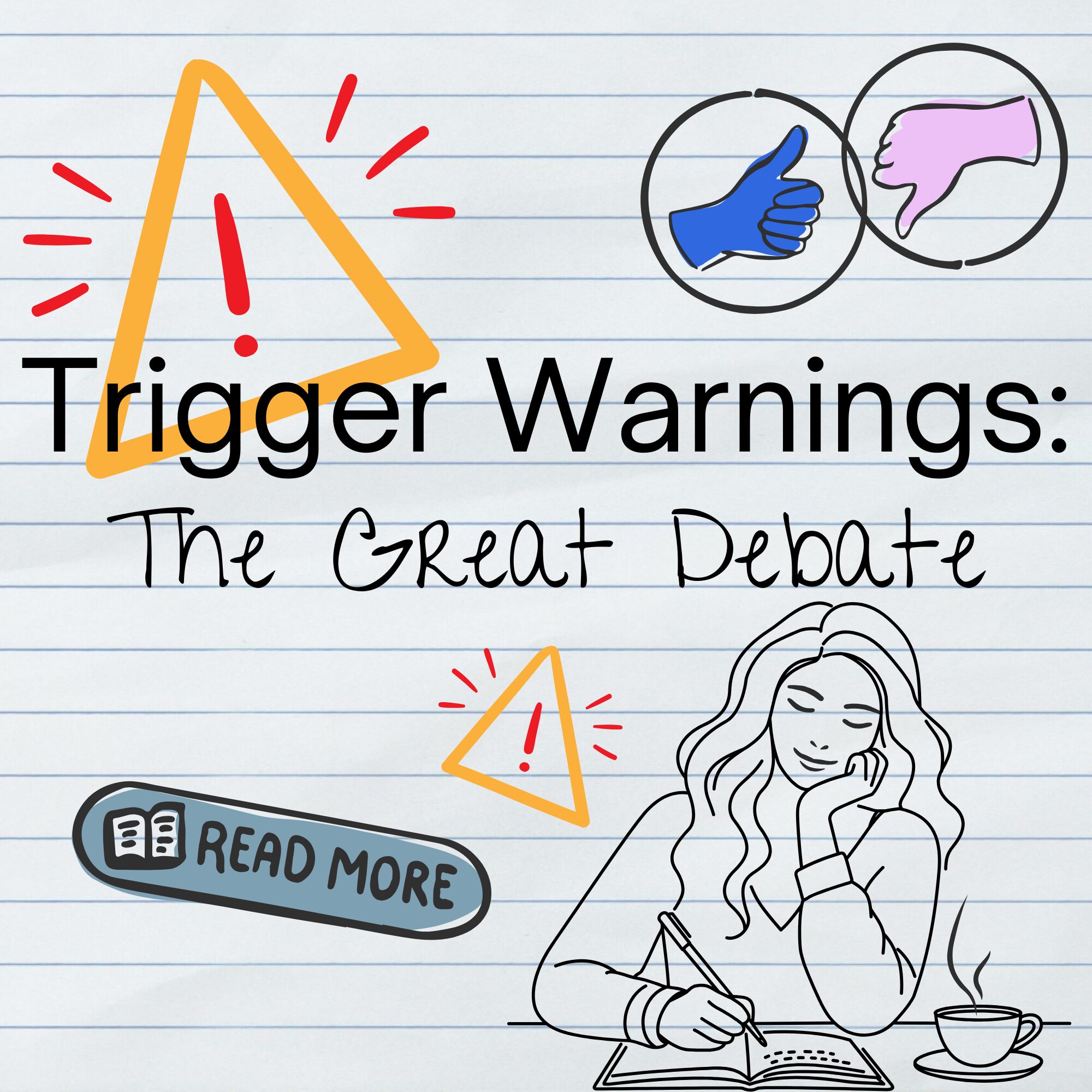
Trigger Warnings, perhaps you’ve heard of them, perhaps not. Recently, trigger warnings (TWs) have become a common theme discussed by readers and authors across multiple genres. So what is a trigger warning and why does anyone care?
Trigger warnings are a list of tropes or themes that occur within a book that might cause an adverse response in readers. Some readers have no issue with any number of socially difficult topics while others may struggle with a negative response depending upon the theme.
The debate around trigger warnings connects strongly with the concern for spoilers as well as the possibility of decreasing the emotion a reader may feel during a certain scene in a book. Authors want readers to feel emotions strongly during their reading. Feelings like dread, rage, love, etc., are common emotions an author may try to evoke in readers.
Authors must determine if and how they plan to provide a trigger warning list for readers. As a reader, I prefer a trigger warning of some kind. While some readers may not have any themes that can trigger negative emotions, I don’t fall into that category. As a reader and writer, here are some options that may work for providing a trigger warning list for authors who worry about spoiling the emotion and details of their book:

Trigger Warning List At The Beginning Of A Book
One common option for providing a list of triggers occurs at the beginning of the book, following the copyright, title, and dedication pages. This location in the book may work well because readers rarely view the front matter of a book, including trigger warning pages, and even sometimes prologues. Authors who still worry about this can provide a two-page trigger warning, a one-page warning of the upcoming triggers for those who wish to skip the list, and one page with the actual list of triggers on it.
This option works well for authors with multiple books and a less sophisticated website. By including the triggers at the beginning of the individual book, authors can address triggers within that book itself as opposed to overall triggers within their various works. This list being available in the book itself also can act as a final moment for readers to determine if the book they’re about to read is for them. In some cases, this may actually help decrease the number of 2 and 1-star reviews an author receives.
Provide A Trigger List On The Author’s Website
Another great option for authors is to provide a list of trigger warnings on their website/ or via pinned posts on social media accounts. By removing the trigger warnings from the book itself, the authors leave it up to the individual reader if they want to take the time to look up the triggers. Those with several triggers that cause negative reactions, may be more likely to take the time to seek out that information, leaving those without triggers to go ahead with their reading.
Digital trigger warning lists can be provided in several ways, making this a versatile option as well. Authors can provide a link to their webpage with the trigger warning, allowing readers to navigate directly to the author’s website or to the page where the triggers are indicated. Another digital option that is becoming more common is a QR code located in the front of the book that a reader can scan with their cell-phone which leads readers directly to the webpage with the trigger list.
The more I think about it, the more I think this is a really great option for readers and authors alike. Not only does it remove the potential of readers seeing a trigger warning list they don’t want to see, but it also allows the author to communicate any possible triggers to readers who do have triggers, ensuring the author is attracting the right audience.
Potential Pitfalls Of Not Including A Trigger Warning Either In The Book Or On An Author Website
There is no shortage of content available for voracious readers today. With the increased popularity of self-publishing through avenues such as Amazon Kindle Direct Publishing, Ingramspark, Barnes & Noble Self-Publishing, as well as other avenues that allow for subscription services and chapter-by-chapter purchasing, there is more than enough reading material to keep a person busy.
It also seems like there is some book or short story that caters to almost every single interest and kink in the romance genre and its multitude of sub-genres. For some, this means that the trigger warning list has become more of a “menu” to choose from. Still others, this may mean opening a romance novel could mean walking into a book where the pages contain a variety of trauma responses.
For readers with triggers, picking up a book that doesn’t have a trigger warning may result in the reader losing interest in the book, DNFing (did not finish) the story, leaving negative reviews or no review at all, and can lead to that reader never reading anything by that author ever again.
Since self-published authors act as way more than the writer alone, building a loyal readership is important to gaining success and keeping it. If something as simple as including a trigger warning page, either in the book itself or on an author’s website, can attract the right readers, wouldn’t it be worth it? The right readers are more likely to leave accurate and honest reviews based on their interest in the book as well as recommend the book and/or author to others, and may become loyal and engaged readers/followers on social media. For a struggling self-published author, all of these things are vital!
Personally, I do have triggers that I prefer to be warned about. Along with a diagnosed anxiety disorder, knowing potentially traumatic information that may come up in a book allows me to be informed while reading, choose books based on the state of my anxiety, and ensure that I continue to enjoy reading. Since reading is essential to my existence, I think that those things outweigh any concern for spoilers that I have.
What about you? Trigger warnings or no trigger warnings? Why?
As always, Happy Reading!



Leave a Reply